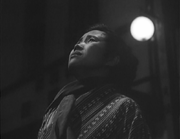A Japanese Tragedy opens to an urgent, chaotic montage of intercut documentary footage and newspaper articles that illustrate the austerity of life in post-occupation Japan. At a shabby, rundown inn in the tourist town of Atami, an itinerant musician (Keiji Sada) plays a melancholic serenade (aptly titled Resort Town Elegy) under an open window, and is invited inside by a senior bar hostess named Haruko Inoue (Yûko Mochizuki) to entertain a group of inebriated businessmen for the evening. Widowed during the Pacific War, Haruko has provided for her children over the turbulent years through the few meager – and often disreputable – enterprises afforded her gender and social class: black market profiteering of household goods, accepting a benefactor’s proposition, working as a prostitute in the pleasure quarters. Now aging and estranged from her adult children, her sole consolation is in the knowledge that her son, Seiichi (Masami Taura) is doing well in his medical studies, and that her daughter, Utako (Yôko Katsuragi) is a highly desirable marriage candidate who speaks fluent English. However, Haruko’s devoted, idealized images of her children’s welfare soon prove to be tenuous when Seiichi’s unexpected visit reveals that he is petitioning to be removed from the family register in order to be adopted by a wealthy family, and that Utako’s purported expenses for dressmaking classes and English lessons are being squandered on vain and selfish interests. Alternately haunted by memories of a desperate and ignoble past, and faced with a seemingly hopeless and lonely future, Haruko struggles to come to terms with her family’s inevitable dissolution.
Keisuke Kinoshita creates a bleak, affecting, and insoluble portrait of postwar existence in A Japanese Tragedy. Using temporal shifts that interweave verité-styled flashbacks and actual newsreel footage within the fictional narrative, Kinoshita creates a relevant and insightful account of the personal toll of war and the slow, agonizing process of recovery: Seiichi and Utako’s reunion at a noodle shop that momentarily cuts to an image of a similar situated, hungry and impatient Seiichi as Utako cooks by an open fire; Haruko’s near-hysterical entreaties to a dispassionate Seiichi that is interrupted by a silent episode of Haruko and other villagers fleeing from the police; Seiichi and Utako’s avoidance of Haruko that transitions to an extended flashback showing two occasions of the children hiding – as Haruko unsuccessfully attempts to evict her abusive brother-in-law from their land, and as they discover their mother’s prostitution through an isolated soundtrack of Haruko’s playful laughter towards a prospective client on the street. Repeated images of trains in motion and bustling stations further reinforce the film’s figurative sense of passage that reflects Japan’s own transition from its oppressive militaristic past, towards a tenuous and politically unstable democracy. In the end, a lone image of Haruko in long shot standing at the top of a train station staircase as commuters hurridly rush past captures the emotional desolation of the individual human struggle against a formidable and unrelenting tide – a sad and haunting reminder of the anonymous victims of an interminable and irreconcilable tragedy.
© Acquarello 2003. All rights reserved.
